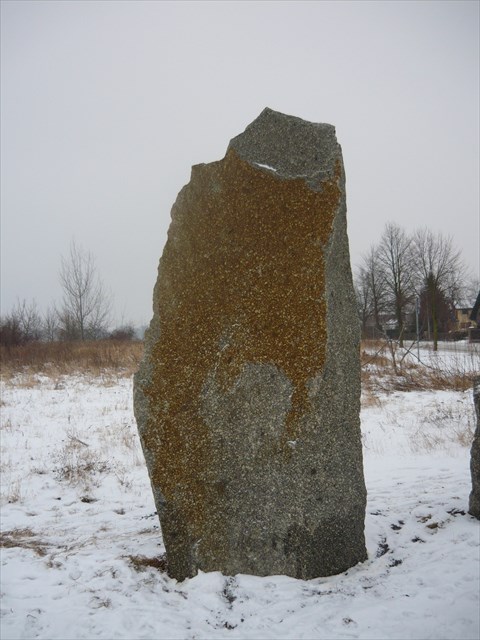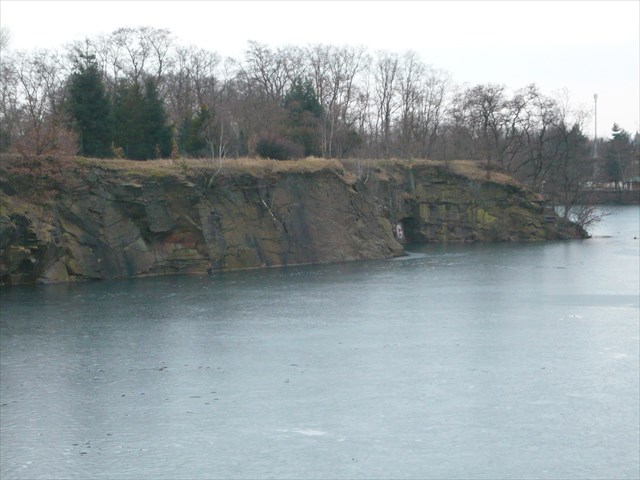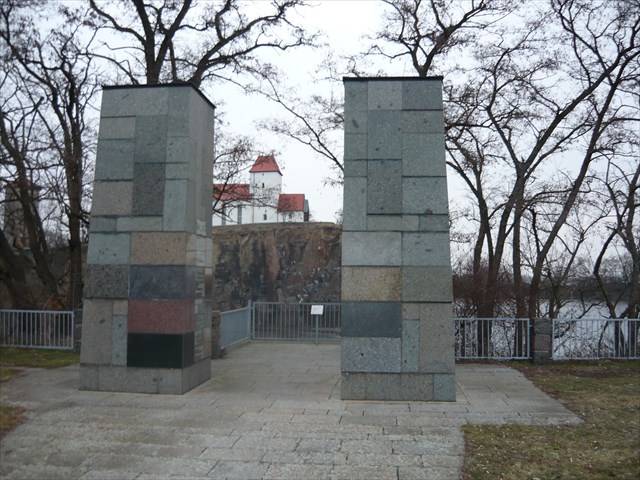
Steinbruch Beuchaer Granitporphyr
Der Beuchaer Granitporphyr ist ein Ergebnis magmatischer Aktivität, zählt deshalb zu den Magmatiten und wird petrographisch als Mikrosyenogranit bezeichnet.
Der Beuchaer Granitporphyr stellt ein vulkanisches Produkt aus der Unterrotliegendzeit (Autun) dar. Im nordwestsächsischen Vulkanitbecken wurden Laven und Tuffen abgelagert und im Zuge einer Intrusion entstand ein Gesteinsvorkommen in der Größe von 9×2 Kilometern. In seiner Entstehungsphase hat der Beuchaer Granitporphyr andere Gesteine wie Grauwacke, Diorit, Gabbro, Hornfels, Lamprophyr, Diabas und Fettquarz als Einschlüsse aufgenommen und zeigt nunmehr ein porphyriges Gefüge. Die Gemengeteile des Beuchaer Granitporphyrs sind Quarz, Orthoklas, Plagioklas, Pyroxen, Chlorit, Biotit und Erzminerale.
Eine wirtschaftliche Nutzung des Beuchaer Granitporphyrs setzte mit dem Jahr 1884 ein, nachdem niederbayerische Steinmetzen nachgewiesen hatten, dass sich der gebrochene Stein aus Beucha sehr gut als Werkstein verarbeiten lässt. Diese Phase des intensiven Abbaus kam mit dem Zweiten Weltkrieg weitestgehend zum Erliegen. Heute wird in Beucha noch Granitporphyr durch ein Unternehmen im Steinbruch „Sorge“, einem Kesselbruch, der in eine flache Erhebung eingetieft ist, abgebaut. Die Abgrabungsfläche beträgt derzeit etwa 6-7 ha. Zukünftig kann sich der Abbau lediglich nach Südosten ausdehnen.
Dieser Naturstein hat eine grüne oder rote mikrokristalline Grundmasse, in der sich millimeter- bis zentimetergroße Einsprenglinge befinden. Die Einsprenglinge bestehen hauptsächlich aus ideomorphen Orthoklasen, Plagioklas, Quarz sowie einigen Erzmineralen und sind optimal verzahnt. Daher ist eine gute Haltbarkeit und Verwitterungsbeständigkeit gegeben. Beuchaer Granitporphyr ist frostfest und polierbar. Die Eigenschaften der Grundmasse und ihre Verzahnung mit den Einsprenglingen zeichnen für die gute Bearbeitbarkeit als Werkstein. Er wird für Treppen- und Bodenbeläge und im Gartenbau verwendet und regional hin und wieder als Grabstein.
Als herausragendes Bauwerk, dass mit Beuchaer Granitporphyr errichtet wurde, ist das Völkerschlachtdenkmal Leipzig zu nennen
Quelle: wikipedia
Bei den Koordinaten N 51° 19.494 E 012° 34.699 könnnt Ihr einen Blick in den ehemaligen Steinbruch werfen.
Um den Cache zu loggen müsst ihr folgende Fragen beantworten:
| Station 1 |
| Frage 1: Wie groß ist der Umfang des größten Steines am Boden? |
| Frage 2: Wieviel Prozent der Steine für das Völkerschlachtdenkmal stammen aus dem Steinbruch "Sorge"? |
| Station 2 |
| Frage 3: Aus welchem Zeitalter stammt der "Valtenberg Syenit"? |
| Frage 4: Welche Farbe hat der "Limbacher Granit"? |
|
Schicke eine eMail mit deinem Nicknamen im Betreff und den Antworten an die Adresse: beuchaer_granit@matthias-jahn.de
Sofern deine Lösung richtig ist, erhältst du die Trackingnummer zum "discovern" unseres Earthcache Coins.
Es wäre schön, wenn du ein Foto von dir und deinem GPS-Gerät zusammen mit deinem Logeintrag einstellen würdest (dies ist allerdings keine Voraussetzung für das Loggen deines Besuchs).
Wir wünschen Euch viel Spaß und sagen Vielen Dank für Euren Besuch.



Quarry Beuchaer Granitporphyr
The granite porphyry of Beucha is a result of magmatic activity. Thats why it is count to the igneous rocks and petrographically as Mikrosyenogranit.
The granite porphyry of Beucha is a volcanic product of the Unterrotliegendzeit (Autun). In the basin of North West Saxon dar lavas and tuffs were deposited and in course of an intrusion a rock deposits in the size of 9 x 2 kilometers was created. In its initial phase, the granite porphyry of Beucha added other rocks like greywacke, diorite, gabbro, hornfels, lamprophyre, diabase and quartzfat as inclusions. Now it shows a porphyriges structure. The mixture components of the granit porphyry of Beucha are orthoclase, plagioclase, pyroxene, chlorite, biotite and ore minerals.
Efficient operation of the granite porphyry of Beucha started with the year 1884, after Lower Bavarian stone masons had shown that the broken stone from Beucha can be worked out very well. This phase of intense degradation ended with the Second World War. Today in Beucha only one company dismatled in the quarry "Sorge", which is deepen in a small rise. The excavation area is currently about 6-7 ha. In the future, the reduceure can extend only to the southeast.
This natural stone has a green or red microcrystalline groundmass, in which millimeter-to centimeter-sized phenocrysts are. The phenocrysts consist mainly of ideomorphen orthoclases, plagioclase, quartz, and some ore minerals and they are dovetailed perfectly. Therefore, a good durability and weathering resistance is given. Beuchaer granite porphyry is frost resistant and possible to polish. The characteristics of the foundation mass and its interaction with the phenocrysts are characterized for good machinability as stone. It is used for stairs and floors and in horticulture and regionally sometimes as a grave stone.
As an outstanding building that was built withe granite porphyry of Beucha is the "Völkerschlachtdenkmal" of Leipzig to call
At coordinates N 51° 19.494 012° 34.699 you can have a look at the former quarry.
To log this cache you have to answer the following questions:
| Station 1 |
| Question 1: How large is the largest stone on the ground? |
| Question 2: What percentage of stone for the "Völkerschlachtdenkmal" are comming from the quarry "Sorge"? |
| Station 2 |
| Question 3: Which era is the "Valtenberg Syenite"? |
| Question 4: What color is the "Limbacher Granit"? |
|
Send an eMail with your nickname as subject and the answers to the following adress: beuchaer_granit@matthias-jahn.de
In case that your solution is accurate, you will get the tracking number for discovering my earthcache coin.
It would be nice if you would take a picture of you and your GPS-Device at one of the viewing points and upload this picture along with your log-entry (however this is not required for logging your visit).
Have fun and we say thank you for your visit.
